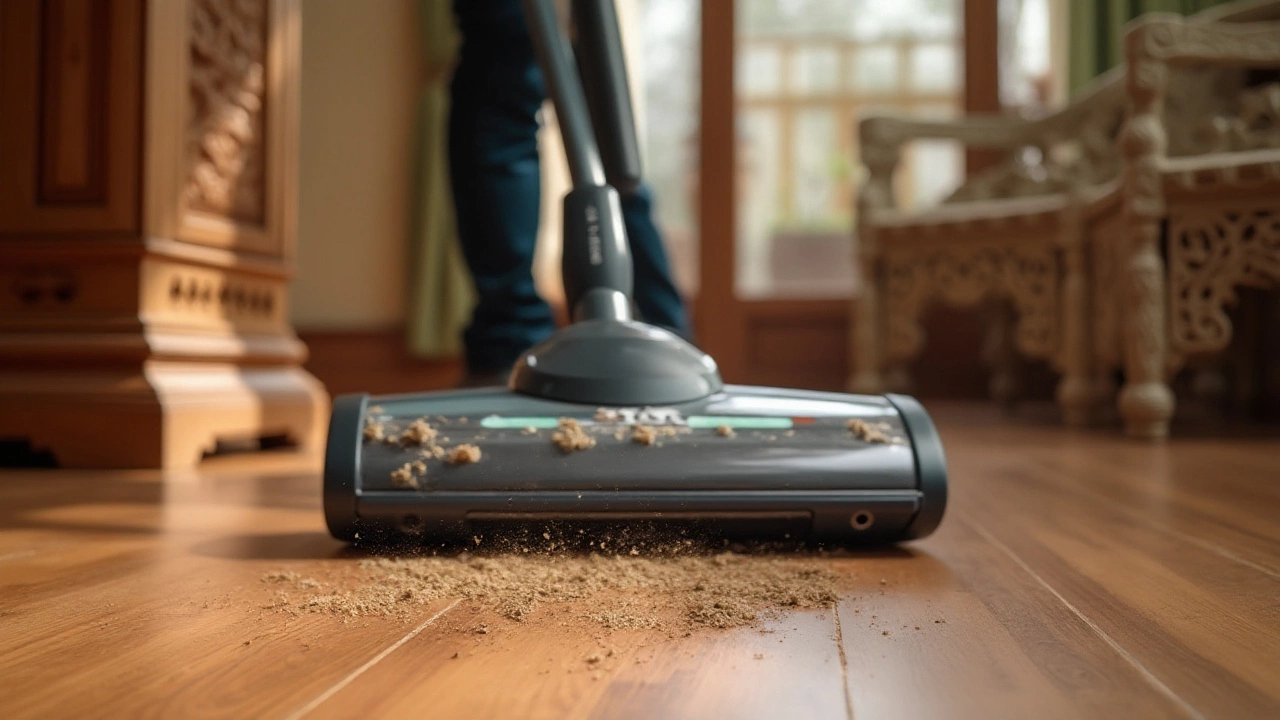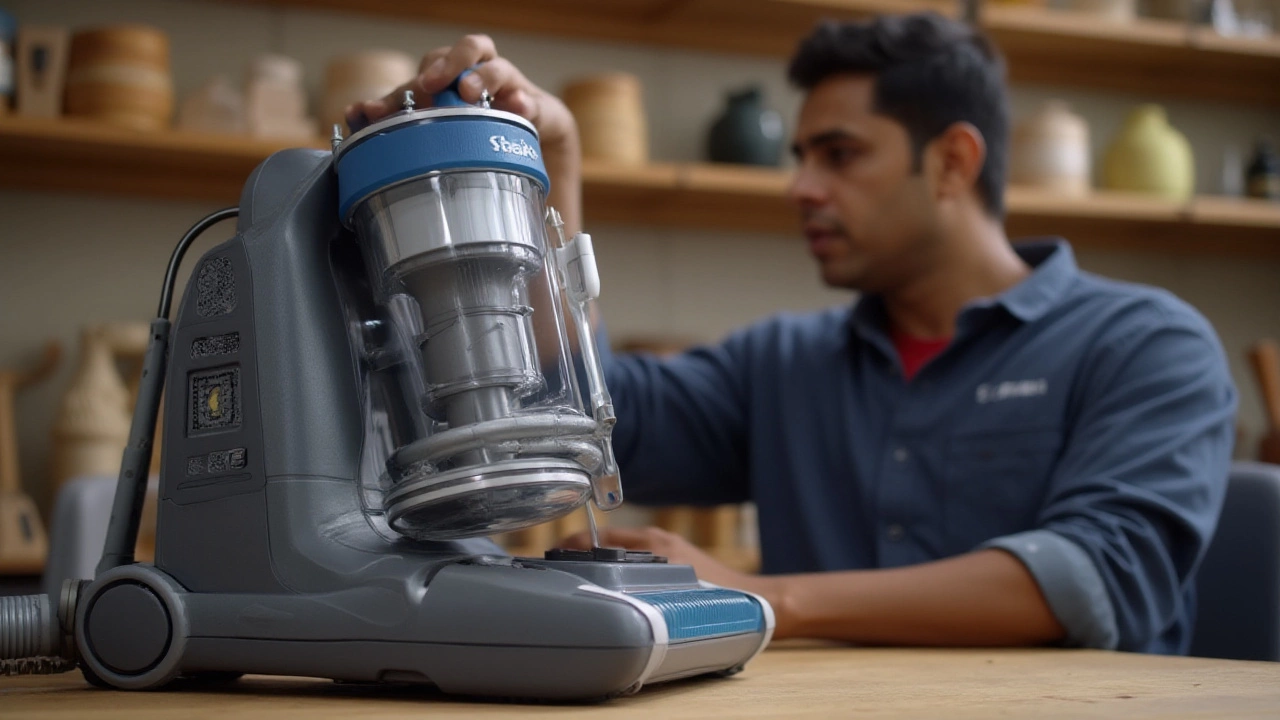
When it comes to cleaning the home, having a reliable vacuum cleaner is crucial. Shark vacuums have earned a reputation for their efficient suction and innovative designs, making them a popular choice among homeowners. But a question often arises: Do they maintain their suction power after prolonged use?
In this article, we'll delve into the inner workings of Shark vacuums to understand why suction issues might occur. We'll also provide practical tips to help you maintain your vacuum's performance, sharing insights from real users to give you a clearer picture of what to expect over time.
- Understanding Shark Vacuum Technology
- Common Causes of Suction Loss
- Effective Maintenance Tips
- User Experiences and Feedback
- When to Consider a Replacement
Understanding Shark Vacuum Technology
Shark vacuums have carved out a prominent place in the world of household cleaning equipment due to their unique blend of innovation and practicality. Notably, the technology behind these vacuums is designed to deliver a powerful and consistent cleaning experience. Central to this is the 'Never Loses Suction' technology, which is a bold claim that relies on the cyclone filtration system. This system efficiently separates fine dirt from the air and prevents the filter from clogging. By doing so, Shark vacuums strive to keep suction power strong irrespective of the vacuumed material, whether it's pet hair or dense dust. The whole idea is rooted in creating a seamless cleaning experience without the tedious task of manually cleaning the filter frequently.
Another interesting aspect of Shark vacuums is their Lift-Away feature. This clever design allows users to easily detach the canister, which can be a game-changer for cleaning staircases or other tricky places. It combines the power and convenience of an upright vacuum with the portability of a handheld device. This feature is particularly valued by owners with versatile cleaning needs. Additionally, the concepts of Anti-Allergen Complete Seal Technology and HEPA filters incorporated into many models highlight their focus on improving air quality. According to some studies, these aspects help capture and trap 99.9% of dust and allergens inside the vacuum, minimizing onset allergens from escaping back into your home. The commitment to air quality and powerful suction is what differentiates Shark vacuums from many others in the market.
Noteworthy is also how Shark has embraced the brush-roll technology known as the DuoClean brush-roll system. This system features dual brush-rolls that work in unison to clean carpets and engage floors for a polished look. The technology is particularly impressive when tackling multi-floor cleaning requirements, displaying the adaptability of Shark vacuums to various surface types. Introduced to counter the hair-wrap issue, the self-cleaning brush-roll continues to advance cleaning efficiency by actively removing hair from the brush-roll while the vacuum is running, a common complaint amongst vacuum users. As per a
“Incorporating technological advancements once reserved for commercial-grade equipment, Shark vacuums bring professional power into household devices,” states a representative from Consumer Reports.
Keeping all these features in mind, it becomes evident that Shark has redefined what a vacuum cleaner can accomplish. By focusing on technology that simplifies and enhances the cleaning process, they've built vacuums that not only excel in suction power but also improve the indoor air quality. It's these winning aspects that contribute to their popularity and reliability.
Shark vacuums are also on the forefront when it comes to ergonomics and user comfort. From their lightweight design that makes maneuvering a breeze to adjustable settings that can be tailored for different cleaning tasks, there's a reason many users become household devotees. Discovering the right model may require familiarizing oneself with these technical aspects to ensure the potential of Shark vacuums is fully realized.
Common Causes of Suction Loss
Understanding the root of suction loss in Shark vacuums is essential to keeping your home clean and your vacuum performing at its best. Suction loss can be a creepingly subtle process. Often, users notice their vacuum struggling to pick up the smallest debris or leaving behind a trail of dirt. One primary cause is blockages in the vacuum system, particularly in the hose or filters. Over time, dust and lint accumulate, clogging the pathways and restricting air flow. Regular maintenance is key here, as many owners often neglect their vacuum’s designated resting perks, leading to inevitable drops in performance. Taking apart the extensions regularly to check for obstructions can increase its effectiveness astonishingly.
The filters play a vital role in ensuring efficient suction power. The Shark vacuum is designed with several types of filters, including pre-motor and HEPA filters, which trap allergens and minute dust particles. However, as they continue filtering the air, these filters get clogged with tiny particles, causing a significant reduction in suction. Scheduled cleaning or replacement of filters can mitigate this cause effectively. A remarkable insight from many users indicates the difference in suction strength after a simple filter swap. "Routine filter checks have transformed our cleaning routine," says a dedicated user on a leading review platform, emphasizing the simplicity and impact of just a basic upkeep.
Another factor that affects suction is the condition of the brush roll. The rotating brush is essential for lifting dust and dirt into the vacuum’s suction path. However, hair, strings, and other tangled materials can entwine around the brush roll, affecting its rotation and thereby disrupting suction. Attending to the brush roll through regular cleaning ensures the vacuums work without hindrance. Often, the brush movents can become unpredictable or erratic, hinting it’s time for a mini-wellness check. It’s also worth noting that overly worn brushes can cause decreased performance, ushering a need for timely replacements to safeguard suction quality.
If your Shark vacuum’s dust cup isn’t emptied routinely, it can lead to suction issues too. A full dust cup restricts the dirt from moving through the airflow path, creating a vacuum inside your vacuum. To maintain peak functionality, an emptied dust bin works wonders, reaffirming why timely clean-ups after each use are inclined to show better results beyond belief. Regularly checking for leaks or cracks in the vacuum body is equally critical. These small openings can leak air, damaging the vacuum’s sealed system, a design element crucial for maintaining suction. It's almost liberating once these small kinks are discovered and quickly resolved, restoring it to almost-new condition.
Lastly, take into account that suction loss might be due to motor issues, which can be a more complex cause. Motors endure wear and tear over time, especially if the vacuum is constantly used or subjected to heavy dirt areas. If the vacuum is well-maintained and suction issues persist, it might be worth consulting a professional to examine the motor. A professional diagnosis could determine whether repair or replacement is necessary. The rarity of motor failures doesn’t downplay its potential impact, where basic technical know-how coupled with practical insight can collectively head the investigation towards a fine conclusion.

Effective Maintenance Tips
Maintaining your Shark vacuum is key to ensuring it delivers consistent suction power throughout its lifespan. The truth is, any vacuum cleaner, no matter the brand, can experience a reduction in suction due to dirt buildup and wear-and-tear if not properly cared for. But with some straightforward steps, you can keep your Shark vacuums operating at peak performance. First off, regular filter cleaning is essential. Depending on the model, Shark vacuums have pre-motor foam and felt filters, and a post-motor filter. It's recommended to wash these filters every three months, unless you use your vacuum extensively, in which case you might want to wash them more frequently. After rinsing the filters with water, let them dry completely before reinserting them. This simple habit not only prevents clogs but also ensures your vacuum runs smoothly.
Another significant factor is the brush roll. Over time, hair and debris can tangle around the brush roll, affecting suction and the vacuum's ability to pick up dirt effectively. Regularly inspecting and cleaning the brush roll can make a world of difference. Most Shark models allow for easy removal of the brush roll, making maintenance straightforward. If you have long hair or pets, consider checking the brush roll after each vacuum session to prevent build-up. A handy tool for this purpose is a pair of scissors or a seam ripper, which can easily cut through tangled hair without damaging the roll. That's the beauty of having a Shark vacuum—they're designed with user-friendly maintenance in mind.
The experts at Good Housekeeping emphasize, "A clean brush roll can significantly enhance your vacuum's performance and contribute to its longevity."
Dust cup maintenance is equally crucial. A full dust cup can decrease the efficiency of your vacuum, so make it a habit to empty it after every use. It might seem like a mundane task, but it ensures that your vacuum's airflow remains unobstructed, which is vital for maintaining suction power. Shark vacuums are designed with easy-release dust cups that make this task less of a chore. Additionally, inspect the vacuum hose for any blockages. Even small obstructions can impact the overall functionality of your vacuum. Simply detach the hose and use a long stick or broom handle to dislodge any trapped debris. Finally, don’t overlook the seals and gaskets of the vacuum. Over time, these parts can wear out, leading to potential leaks that might affect suction. Regular inspection ensures that any minor issues are addressed promptly.
Troubleshooting Common Issues
Sometimes, despite your best efforts, you might find your vacuum not performing as well as it should. Shark vacuums come equipped with diagnostic lights or indicators that help in identifying issues before they become serious. Pay attention to these signals. If the vacuum seems to lose power, it could be as simple as a tripped circuit breaker or a tangled brush roll. On the rare occasion that deeper issues arise, many Shark models come with a five-year limited warranty, which is a testament to their confidence in product longevity. The warranty typically covers parts and labor, giving you peace of mind if repairs are needed. Remember, regular maintenance isn't just about preserving suction—it's about protecting your investment. Proper care prolongs the life of your vacuum, ultimately saving you money and hassle.
User Experiences and Feedback
Many users have chosen to share their stories about using Shark vacuums online, and the general consensus seems to remark on their impressive performance. One user posted on a popular review website, mentioning how their Shark vacuum still has the same suction power after three years of regular use, thanks to routine filter cleaning and replacing parts when necessary. However, as with all products, not everyone shares the same experience. Some individuals report noticing a gradual decrease in suction, usually attributing the problem to clogged filters or hoses, which aren't uncommon issues for any vacuum cleaner.
It is noteworthy that the experiences and perceptions of suction loss can vary significantly depending on the model and care of the vacuum. Common praise points include the durability and user-friendly nature of these vacuums. Users appreciate the versatility offered by models that can switch between hard floors and carpets without losing a beat. Yet, some users have found the maintenance instructions less intuitive and more detailed than anticipated, which can contribute to perceived performance decline if not followed thoroughly.
On platforms such as Amazon, a variety of feedback is shown through customer ratings and reviews. In a particular review, a user emphasized how critical regular maintenance is for ensuring their Shark vacuum continues to work efficiently, highlighting the pivotal role of experts' advice found in user manuals and online support. They kept track of their vacuum's parts, ensuring timely filter replacements and keeping the brush roll clean. This, they stated, had led their vacuum to outlast similar machines their neighbors owned.
"I've tried several vacuums over the years, but my Shark has remained a staple in my cleaning routine. Regular cleaning of the dust cup and filters keeps it in top condition," said a satisfied user on a vacuum enthusiast forum. They elaborated further on how, in their experience, failure to upkeep these practices was often the root cause of suction loss.
For users facing potential performance issues, documenting the frequency of each cleaning session and part replacement can help anticipate when a significant maintenance step is due. It's also beneficial for users to engage with customer support, which can offer insights unseen in the standard manuals. As one user noted, customer support helped diagnose a suction issue due to inadequate air flow caused by an overlooked blockage. These stories emphasize the importance of both routine maintenance and seeking assistance when problems arise.
Despite mixed reviews, the resilience and robust design of Shark vacuums earn them a loyal customer base who swear by them due to their strong suction and reliability. Of course, consistent care and the keen observation of user reviews ensure these vacuums remain in peak condition for the longest possible time, living up to their potential as one of the most trusted names in the home cleaning world.

When to Consider a Replacement
After years of faithful service, even the most dependable Shark vacuums might start showing signs that it's time to retire them. Understanding when to replace your vacuum is crucial for maintaining a clean and healthy home environment. Typically, one significant indicator is a noticeable decrease in suction power that isn't remedied by routine maintenance, such as cleaning filters or checking the brush roll for debris. If you've followed all the manufacturer's guidelines and your vacuum still struggles, it might be time to consider an upgrade.
Another point to consider is the age of your vacuum. Most vacuums, not just Sharks, have a lifespan of eight years, on average, though this can vary based on usage and maintenance. If your vacuum is nearing or past this mark and frequently malfunctioning, it's worth evaluating the cost of repairs versus investing in a new one. In some cases, the cost of repairing critical components, such as the motor or circuits, may not justify the expense, particularly if the repairs become frequent.
Sometimes, the need for a replacement isn't solely about performance but also about evolving household needs. For instance, you might have switched from carpeted floors to hardwood or acquired a pet that sheds excessively. Your old vacuum might not be up to the task of handling such changes. Newer models come with technology tailored for specific tasks, like advanced filtration systems for pet dander or features that work optimally on multiple surfaces.
"Regularly checking your vacuum's performance and comparing it with the latest models’ features can help you decide if a new purchase is necessary. Technology advances can significantly enhance cleaning efficiency and air quality within your home," suggests Mark Hamilton, an expert in home appliances from Clean Living Magazine.
A practical step you can take is to compare your current vacuum with the latest models on the market. New-generation vacuums often come equipped with smart technology, making cleaning more efficient and less time-consuming. If you notice your older model lagging in features such as EnergyStar efficiency ratings, advanced allergen-blocking capabilities, or self-cleaning mechanisms, consider those as indicators for potential replacement. The shift from a dated model to one boasting innovative features can dramatically transform your cleaning routine.